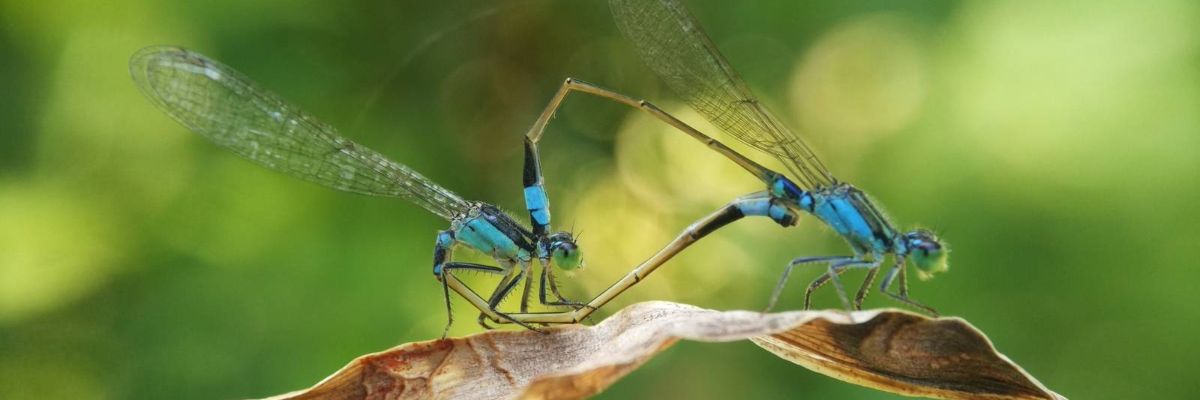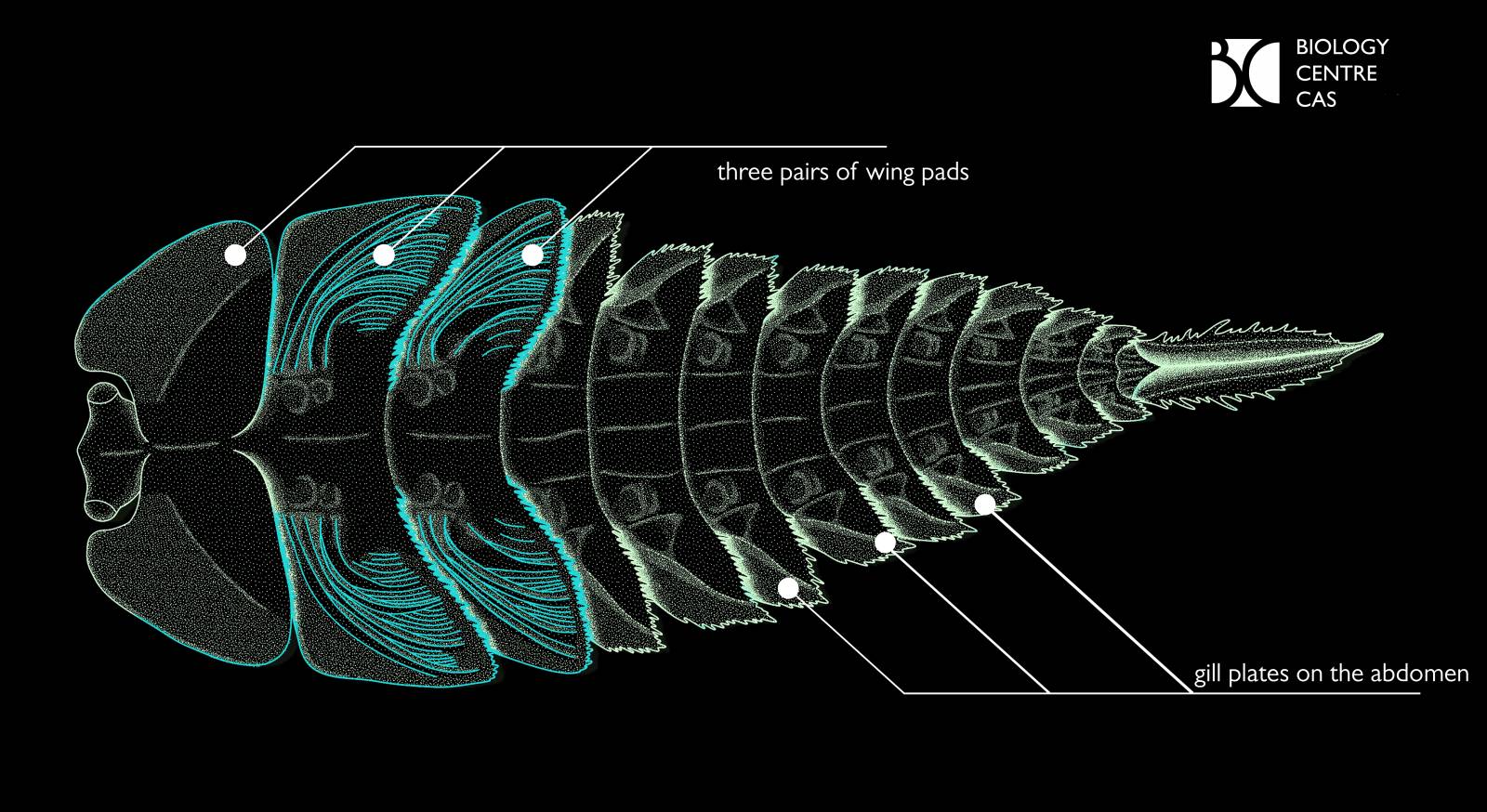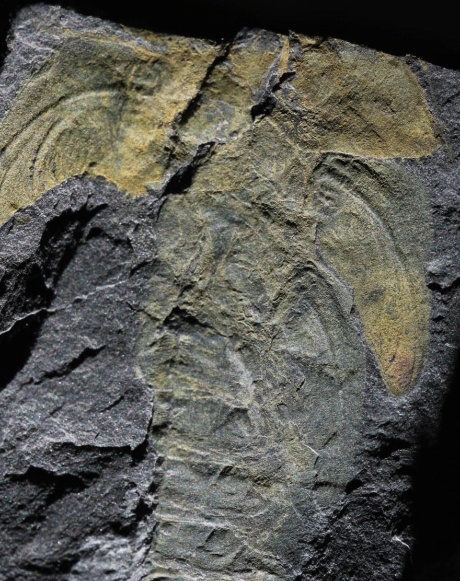
Insect wings may have evolved from gills, scientists hypothesize
10. 01. 2024
How did insects get their wings? A still unsolved mystery of evolution. Despite years of research, it is not entirely clear which body structure insect wings actually evolved from and what their original function was prior to being able to handle active flight. Scientists from the Biology Centre of the CAS offer a possible answer to this question, having found a clue in newly discovered prehistoric fossils of an ancient group of insects. The study is published in Communications Biology.
Various theories regarding the origin of insect wings are at play here, and to some extent, it depends on whether the common ancestor of winged insects lived in an aquatic or terrestrial environment. While several scientific studies have linked the origin of wings to the gills of certain aquatic insects, hypotheses that advocate a terrestrial origin for winged insects are more prevalent at the moment.

Reconstruction of K. brauneri larva, based on all discovered fossil specimens. Drawing: Kateřina Rosová.
New evidence has been supplied by an international team of researchers from the Biology Centre of the CAS, Charles University (Prague), and Museum Schölerberg. Czech entomologists together with their German colleagues found new Palaeozoic fossils of larvae of an ancient group of insects, named the Palaeodictyoptera, from the Carboniferous period (extinct at the end of the Palaeozoic Era) in a quarry in Lower Saxony. With their body structure, these larvae resemble a hypothetical winged insect ancestor, providing new clues to unraveling this evolutionary mystery.
In the fossils, scientists discovered several adaptations for life in aquatic environments – most notably, several pairs of lateral outgrowths on the abdomen that likely functioned as gills. In the larvae, they also observed the bases of three pairs of future wings on the thorax, their detailed structure being very similar to the aforementioned abdominal plate-like gills. It can therefore be assumed that these so-called wing pads were also involved in oxygen uptake from the aquatic environment.
“Although it is certain that our fossils do not represent the ancestor of winged insects – these are fossils of larvae, and the adults of this group already had fully functional wings – it is still a relatively ancient group of insects. Given the fact that the larvae of other ancient insect taxa such as mayflies and dragonflies are also aquatic, it supports the possibility that the aquatic environment played an important role in the very beginnings of the evolution of winged insects,” suggests Pavel Sroka from the Institute of Entomology at the Biology Centre of the CAS. “The first forms of flattened outgrowths on the thorax, which later gave rise to wings, may have originated as organs designed for respiration, similar to what we see with the wing pads on our fossils,” the entomologist adds.

Fossil of the newly described species K. brauneri. Wing pads on both sides of the body are partially preserved and visible. Photo: Jakub Prokop
Publication
Prokop, J., Rosová, K., Leipner, A., Sroka, P. Thoracic and abdominal outgrowths in early pterygotes: a clue to the common ancestor of winged insects?. Commun Biol 6, 1262 (2023). https://doi.org/10.1038/s42003-023-05568-6
Prepared by: Markéta Wernerová, External Relations Division, CAO of the CAS, drawing on the CAS press release (in Czech)
Translated by: Tereza Novická, External Relations Division, CAO of the CAS
Photo: Shutterstock; Biology Centre of the CAS
 The text is released for use under the Creative Commons license.
The text is released for use under the Creative Commons license.
Read also
- A trapped state: The pandemic impact on public attitudes, trust, and behavior
- Aerial archaeology: Tracing the footsteps of our ancestors from the sky
- Archaeologists uncover ancient finds along Prague Ring Road
- Our microbiome largely depends on what we eat, says microbiologist Michal Kraus
- The ABCs of writing: Why did its invention mark a turning point for humankind?
- We learn, remember, forget… What can memory actually do? And can we outsmart it?
- New Center for Electron Microscopy in Brno opens its doors to global science
- The hidden lives of waste: What can we learn from waste workers and pickers?
- A unique lab is hidden right beneath Prague’s Vítkov Hill
- Renewables are a strategic investment in European security, scientists say
The Czech Academy of Sciences (the CAS)
The mission of the CAS
The primary mission of the CAS is to conduct research in a broad spectrum of natural, technical and social sciences as well as humanities. This research aims to advance progress of scientific knowledge at the international level, considering, however, the specific needs of the Czech society and the national culture.
President of the CAS
Prof. Eva Zažímalová has started her second term of office in May 2021. She is a respected scientist, and a Professor of Plant Anatomy and Physiology.
She is also a part of GCSA of the EU.